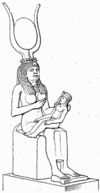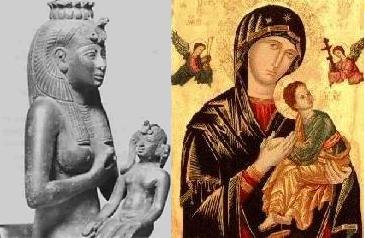Isis
2008/9 Schools Wikipedia Selection. Related subjects: Divinities
Isis is a goddess in Ancient Egyptian mythology and is celebrated as the ideal mother and wife, patron of nature and magic; friend of slaves, sinners, artisans, the downtrodden, as well as listening to the prayers of the wealthy, the maiden, the aristocrat and emperor. In union with her husband and brother Osiris she conceived Horus. Isis was instrumental in the resurrection of Osiris when he was murdered by Seth. The goddess Isis was the first daughter of Geb, god of the Earth, and Nut, the goddess of the Overarching Sky, and was born on the fourth intercalary day, correspondence having been made in the modern calendar with July the 17th.
She is also known as the goddess of simplicity, from whom all Beginnings arose, and as the Lady of bread, of beer and of green fields. Ancient Egyptians believed that the Nile flooded every year because of her tears of sorrow for her dead husband, Osiris.
Etymology
| Isis in hieroglyphs |
||||
|
The English pronunciation used for this deity, /ˈaɪ.sɪs/, is an Anglicized pronunciation of the Greek name, Ίσις, which itself changed the original Egyptian name by the addition of a final "-s" because of the grammatical requirements of Greek noun endings. The Egyptian name was recorded as ỉs.t or ȝs.t and meant "(She of the) Throne." However, the true Egyptian pronunciation remains uncertain because their writing system did not always feature vowels. Based on recent studies which present us with approximations based on contemporary languages and Coptic evidence, the reconstructed pronunciation of her name is *ʔŪsat (ooh-saht). Later, the name survived into Coptic dialects as "Ēse" or "Ēsi," as well as in compound words surviving in names of later people like " Har-si-Ese," literally "Horus, son of Isis."
Her name literally means "queen of the throne." Her original headdress was an empty throne chair belonging to her murdered husband, Osiris. As the personification of the throne, she was an important source of the Pharaoh's power. Her cult was popular throughout Egypt, but the most important sanctuaries were at Giza and at Behbeit El-Hagar in the Nile delta.
For convenience and arbitrarily, Egyptologists choose to pronounce the word as "ee-set." Sometimes they may also say "ee-sa" because the final "t" in her name was a feminine suffix, which is known to have been dropped in speech during the last stages of the Egyptian language.
Origins
Her origins are uncertain but are believed to have come from the Nile Delta; however, unlike other Egyptian deities, she did not have a centralized cult at any point throughout her worship. First mentions of Isis date back to the Fifth dynasty of Egypt which is when the first literary inscriptions are found, but her cult became prominent late in Egyptian history, when it began to absorb the cults of many other goddesses. It eventually spread outside Egypt.
During the formative centuries of Christianity, the religion of Isis was drawing converts from every corner of the Roman Empire. In Italy itself, the Egyptian faith was a dominant force. At Pompeii, archaeological evidence reveals that Isis played a major role. In Rome, temples were built and obelisks erected in her honour. In Greece, traditional centres of worship in Delos, Delphi and Eleusis were taken over by followers of Isis, and this practice followed suit in northern Greece and in Athens. Harbours of Isis were to be found on the Arabian Sea and the Black Sea. Inscriptions show followers in Gaul and Spain, in Pannonia and Germany, in Arabia and Asia Minor, Portugal, Ireland, and many shrines in Britain.
Temples
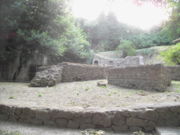
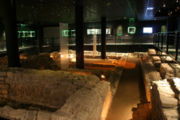
Most Egyptian deities started as strictly local, and throughout their history retained local centres of worship, with most major cities and towns widely known as the hometowns to their deities. Isis was originally an independent and popular deity established in pre-dynastic times at Sebennytos in the northern delta.
Eventually temples to Isis began to spread outside of Egypt. In many locations, particularly Byblos, her cult took over that of worship to the Semitic goddess Astarte, apparently due to the similarity of names and associations. During the Hellenic era, due to her attributes as a protector, and mother, and the lusty aspect originally from Hathor, she was also made the patron goddess of sailors.
Likewise, the Arabian goddess Al-Ozza or Al-Uzza العُزّى (al ȝozza), whose name is close to that of Isis, is believed to be a manifestation of her. This however is based on similarity in the name.
Throughout the Graeco-Roman world, Isis became one of the most significant of the mystery religions, and many classical writers refer to her temples, cults and rites. Temples to Isis were built in Iraq, Greece, Rome, Pompeii. At Philae her worship persisted until the sixth century, long after the rise of Christianity and the suppression of paganism. Philae was the last of the ancient Egyptian temples to be closed.
Priesthood
Little information on Egyptian priests of Isis survives; however, it is clear there were both priests and priestesses of her cult throughout her history. By the Graeco-Roman era, many of them were healers, and were said to have many other special powers, including dream interpretation and the ability to control the weather by braiding or combing their hair, the latter of which was believed because the Egyptians considered knots to have magical powers.
Iconography
Associations
| " tyet" Knot of Isis in hieroglyphs |
||
|
Because of the association between knots and magical power, a symbol of Isis was the tiet/ tyet (meaning welfare/life), also called the Knot of Isis, Buckle of Isis, or the Blood of Isis. The tiet in many respects resembles an ankh, except that its arms curve down, and in all these cases seems to represent the idea of eternal life/ resurrection. The meaning of Blood of Isis is more obscured, but the tyet was often used as a funerary amulet made of red wood, stone, or glass, so this may have simply been a description of its appearance.
The star Spica (sometimes called Lute Bearer), and the constellation which roughly corresponded to the modern Virgo, appeared at a time of year associated with the harvest of wheat and grain, and thus with fertility gods and goddesses. Consequently they were associated with Hathor, and hence with Isis through her later conflation with Hathor. Isis also assimilated Sopdet, the personification of Sirius, since Sopdet, rising just before the flooding of the Nile, was seen as a bringer of fertility, and so had been identified with Hathor. Sopdet retained an element of distinct identity, however, as Sirius was quite visibly a star and not living in the underworld (Isis being the wife of Osiris who was king of the underworld).
In the Roman period, probably due to assimilation with the goddesses Aphrodite and Venus, the rose was used in her worship. The demand for roses throughout the Empire turned rose growing into an important industry.
Titles
In the Book of the Dead Isis was described as:
- She who gives birth to heaven and earth,
- She who knows the orphan,
- She who knows the widow spider,
- She who seeks justice for the poor people,
- She who seeks shelter for the weak people
Some of Isis's many other titles were:
- Queen of Heaven,
- Mother of the Gods,
- The One Who is All,
- Lady of Green Crops,
- The Brilliant One in the Sky,
- Star of the Sea,
- Great Lady of Magic,
- Mistress of the House of Life,
- She Who Knows How To Make Right Use of the Heart,
- Light-Giver of Heaven,
- Lady of the Words of Power,
- Moon Shining Over the Sea.
Depictions
In art, originally Isis was pictured as a woman wearing a long sheath dress and crowned with the hieroglyphic sign for a throne, sometimes holding a lotus, as a Sycamore tree. After her assimilation of Hathor, Isis's headdress is replaced with that of Hathor: the horns of a cow on her head, and the solar disc between them. She was also sometimes symbolised by a cow, or a cow's head. Usually, she was depicted with her young son, the great god Horus, with a crown and a vulture, and sometimes as a kite flying above Osiris's body or with the dead Osiris across her lap.
Isis is most often seen holding only the generic ankh sign and a simple staff, but is sometimes seen with Hathor's attributes, the sacred sistrum rattle and the fertility bearing menat necklace. In The Book of Coming Forth By Day Isis is depicted standing on the prow of the Solar Bark with arms outstretched.
The star Sept (Sirius) depicts Isis, which is the star of the new year. The appearance of the star signified the advent of a new year and so Isis was considered the goddess of rebirth and reincarnation and as a protector of the dead. The Book of the Dead outlines a particular ritual that would protect the dead so that he can go anywhere in the under world. Most of the names Isis holds signify her as the goddess of protection of the dead.
Isis in literature
Isis is the most important goddess in Egyptian mythology who transferred from a local goddess in the Nile Delta to a cosmic goddess all over the ancient world. The name Isis is still a beloved name among modern Coptic Egyptians, and in Europe the name (Isadora) i.e. Gift of Isis is still common.
Plutarch's Isis and Osiris is considered a main source in which he writes of Isis: "she is both wise, and a lover of wisdom; as her name appears to denote that, more than any other, knowing and knowledge belong to her." and that the shrine of Isis in Sais carried the inscription "I am all that hath been, and is, and shall be; and my veil no mortal has hitherto raised."In The Golden Ass the Roman writer Apuleius' gives us an understanding of Isis in the second century. The following paragraph is particularly significant:
| “ | You see me here, Lucius, in answer to your prayer. I am nature, the universal Mother, mistress of all the elements, primordial child of time, sovereign of all things spiritual, queen of the dead, queen also of the immortals, the single manifestation of all gods and goddesses that are, my nod governs the shining heights of Heavens, the wholesome sea breezes. Though I am worshipped in many aspects, known by countless names ... some know me as Juno, some as Bellona ... the Egyptians who excel in ancient learning and worship call me by my true name...Queen Isis. | ” |
Mythology
| Isis in hieroglyphs |
||||||||
|
As the deification of the wife of the Pharaoh, the first prominent role of Isis was as the assistant to the deceased king. Thus she gained a funerary association, her name appearing over 80 times in the Pyramid Texts, and was said to be the mother of the four gods who protected the canopic jars - more specifically, Isis was viewed as protector of the liver-jar-god Imsety. This association with the Pharaoh's wife also brought the idea that Isis was considered the spouse of Horus, who was protector, and later the deification, of the Pharaoh himself. By the Middle Kingdom, as the funeral texts spread to be used by non-royals, her role also grows to protect the nobles and even the commoners.
By the New Kingdom, Isis gains prominence as the mother / protector of the Pharaoh. She is said to breastfeed the Pharaoh with her milk, and is often depicted visually as such. The role of her name and her throne-crown is uncertain. Some Egyptologists believe that being the throne-mother was Isis's original function, however a more modern view states that aspects of the role came later by association. In many African tribes, the king's throne is known as the mother of the king, and that fits well with either theory, giving us more insight into the thinking of ancient Egyptians.
Sister-wife to Osiris
In another area of Egypt, Isis became one of the Ennead of Heliopolis, as a daughter of Nut and Geb, and sister to Osiris, Nephthys, and Seth. As a funerary deity, she was associated with Osiris, god of the underworld ( Duat), and thus was considered his wife. The two females - Isis and Nephthys - were often depicted on coffins, with wings outstretched, as protectors against evil.
A later legend (ultimately a result of the replacement of another god of the underworld when the cult of Osiris gained more authority), tells of the birth of Anubis. The tale describes how Nephthys became sexually frustrated with Set and disguised herself as the much more attractive Isis to try to seduce him. The plot failed, but Osiris now found Nephthys very attractive, as he thought she was Isis. They coupled, resulting in the birth of Anubis. In fear of Set's anger, Nephthys persuaded Isis to adopt Anubis, so that Set would not find out. The tale describes both why Anubis is seen as an underworld deity (he is a son of Osiris), and why he could not inherit Osiris's position (he was not a legitimate heir), neatly preserving Osiris's position as lord of the underworld. However, it should be remembered that this story was only a later creation of the Osirian cult who wanted to depict Set in an evil position, as the enemy of Osiris.

In another myth, Set had a banquet for Osiris in which he brought in a beautiful box and said that whoever could fit in the box perfectly would get to keep it. Set had measured Osiris in his sleep so that he was the only person that could fit in the box. Once it was Osiris's turn to see if he could fit in the box, Set closed the lid on him so that the box was now a coffin for Osiris. Set flung the box in the Nile so that it would float far away; Isis went looking for the box so that Osiris could have a proper burial. She found the box in a tree in Byblos, and brought it back to Egypt, hiding it in a swamp. Set went hunting that night and found the box. To make it so Isis could never find Osiris again, Set chopped Osiris's body into fourteen pieces and scattered them all over Egypt. Isis and her sister Nephthys went looking for his pieces, but could only find thirteen of the fourteen. Fish had swallowed the last piece, his penis, so Isis fashioned one out of gold. Isis used her magic to put Osiris's body back together and managed to bring him back to life, in which they conceived Horus.
Assimilation of Hathor
Beliefs about Ra himself had been hovering around the identification of Ra, a sun god, with Horus, another sun god (as the compound Ra-Herakhty), and so for some time, Isis had intermittently been considered the wife of Ra, since she was the mother of Horus. Consequently, since there was not anything logically troubling by identifying Isis as Ra's wife, Hathor unlike identifying Ra as her own son, she and Hathor became considered the same deity, Isis-Hathor. Sometimes the alternative consideration arose, that Isis, in the Ennead, was a child of Atum-Ra, and so should have been a child of Ra's wife, Hathor, although this was less favoured as Isis had enough in common with Hathor to be considered one and the same.
Mother of Horus
It was this merger with Hathor that proved to be the most significant event in the history of Egyptian mythology. By merging with Hathor, Isis became the mother of Horus, rather than his wife, and thus, when beliefs of Ra absorbed Atum into Atum-Ra, it also had to be taken into account that Isis was one of the Ennead, as the wife of Osiris. However, it had to be explained how Osiris, who (as god of the dead) was dead, could be considered a father to Horus, who was not considered dead. This led to the evolution of the idea that Osiris needed to be resurrected, and so to the Legend of Osiris and Isis, of which Plutarch's De Iside et Osiride contains the most extensive account known today, a myth so significant that it is the most famous of all Egyptian myths.
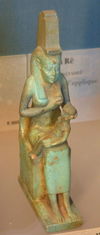
Yet another set of myths detail the adventures of Isis after the birth of Osiris's posthumous son, Horus. Many dangers faced Horus after birth, and Isis fled with the newborn to escape the wrath of Set, the murderer of her husband. In one instance, Isis heals Horus from a lethal scorpion sting; she also performs other miracles in relation to the so-called cippi, or the plaques of Horus. Isis protected and raised Horus until he was old enough to face Set, and subsequently became the king of Egypt.
Magic
In order to resurrect Osiris for the purpose of having the child Horus, it was necessary for Isis to learn magic, and so it was that Isis tricked Ra (i.e. Amun-Ra/Atum-Ra) into telling her his "secret name," by causing a snake to bite him, to which Isis had the only cure, so that he would use his "secret name" to survive. This aspect becomes central in magic spells, and Isis is often implored to use the true name of Ra while performing rituals. By the late Egyptian history, Isis becomes the most important and most powerful magical deity of the Egyptian pantheon. Magic is central to the entire mythology of Isis, arguably more so than any other Egyptian deity.
In consequence of her deeply magical nature, Isis also became a goddess of magic (though Thoth was always the leading god of magic). The prior goddess to hold the quadruple roles of healer, protector of the canopic jars, protector of marriage, and goddess of magic, Serket, became considered an aspect of her. Thus it is not surprising that Isis had a central role in Egyptian magic spells and ritual, especially those of protection and healing. In many spells, she is also completely merged even with Horus, where invocations of Isis are supposed to automatically involve Horus's powers as well.
Assimilation of Mut
After the authority of Thebes had risen, and made Amun into a much more significant god, it later waned, and Amun was assimilated into Ra. In consequence, Amun's consort, Mut, the doting, infertile, and implicitly virginal mother, who by this point had absorbed other goddesses herself, was assimilated into Ra's wife, Isis-Hathor as Mut-Isis-Nekhbet. On occasion, Mut's infertility and implicit virginity was taken into consideration, and so Horus, who was too significant to ignore, had to be explained by saying that Isis became pregnant with magic when she transformed herself into a kite and flew over Osiris' dead body.
Mut's husband was Amun, who had by this time become identified with Min as Amun-Min (also known by his epithet - Kamutef). Since Mut had become part of Isis, it was natural to try to make Amun, part of Osiris, the husband of Isis, but this was not easily reconcilable, because Amun-Min was a fertility god and Osiris was the god of the dead. Consequently they remained regarded separately, and Isis was sometimes said to be the lover of Min. Subsequently, as at this stage Amun-Min was considered an aspect of Ra (Amun-Ra), he was also considered an aspect of Horus, since Horus was identified as Ra, and thus Isis's son was on rare occasions said to be Min instead, which neatly avoided having confusion over Horus's status as was held at being the husband and son of Isis.
Isis outside Egypt
Following the conquest of Egypt by Alexander of Macedon the worship of Isis spread throughout the Graeco-Roman world. Tacitus writes that after Julius Caesar's assassination, a temple in honour of Isis had been decreed; Augustus suspended this, and tried to turn Romans back to the Roman gods who were closely associated with the state. Eventually the Roman emperor Caligula abandoned the Augustan wariness towards oriental cults, and it was in his reign that the Isiac festival was established in Rome. According to Josephus, Caligula himself donned female garb and took part in the mysteries he instituted, and Isis acquired in the Hellenistic age a "new rank as a leading goddess of the Mediterranean world." Vespasian along with Titus practised incubation in the Roman Iseum. Domitian built another Iseum along with a Serapeum. Trajan appears before Isis and Horus, presenting them with votive offerings of wine, in a bas-relief on his triumphal arch in Rome. Hadrian decorated his villa at Tibur with Isaic scenes. Galerius regarded Isis as his protectress.
Roman perspectives on cult were syncretic, seeing in new deity merely local aspects of a familiar one. For many Romans, Egyptian Isis was an aspect of Phrygian Cybele, whose orgiastic rites were long naturalized at Rome, indeed, she was known as Isis of Ten Thousand Names. Among these names of Roman Isis, Queen of Heaven is outstanding for its long and continuous history. Herodotus identified Isis with the Greek and Roman goddesses of agriculture, Demeter and Ceres. In later years, Isis also had temples throughout Europe, Africa, and Asia.
Parallels in Catholicism and Orthodoxy
Scholars have drawn comparisons with Isis worship in late Roman times and the cult of the Blessed Virgin Mary. For example, the historian Will Durant has claimed, "Early Christians sometimes worshiped before the statues of Isis suckling the infant Horus, seeing in them another form of the ancient and noble myth by which woman (i.e., the female principle), creating all things, becomes at last the Mother of God." Though the Virgin Mary is not worshiped (only venerated) in Catholicism and Orthodoxy, her role as a merciful mother figure has parallels with the figure of Isis.
Worship of Isis in modern times
Isis is worshiped in modern times, commonly within the context of neo-pagan spiritual movements. Organizations such as the Fellowship of Isis promote the spreading of Goddess worship and attract members from the wider Wiccan, Qabalah, Rosicrucianism, Celtic Mysteries, Zen, Sufi and Tao paths.
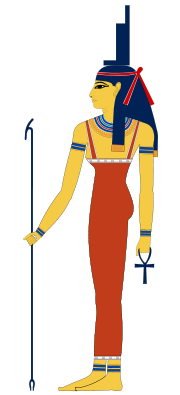
![Q1 [st] st](../../images/803/80338.png)
![X1 [t] t](../../images/578/57853.png)

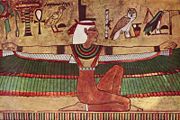
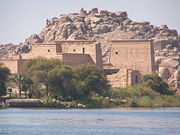
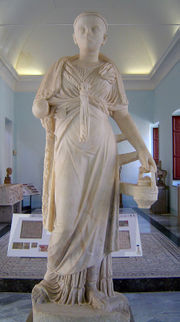


![Z4 [y] y](../../images/803/80352.png)

